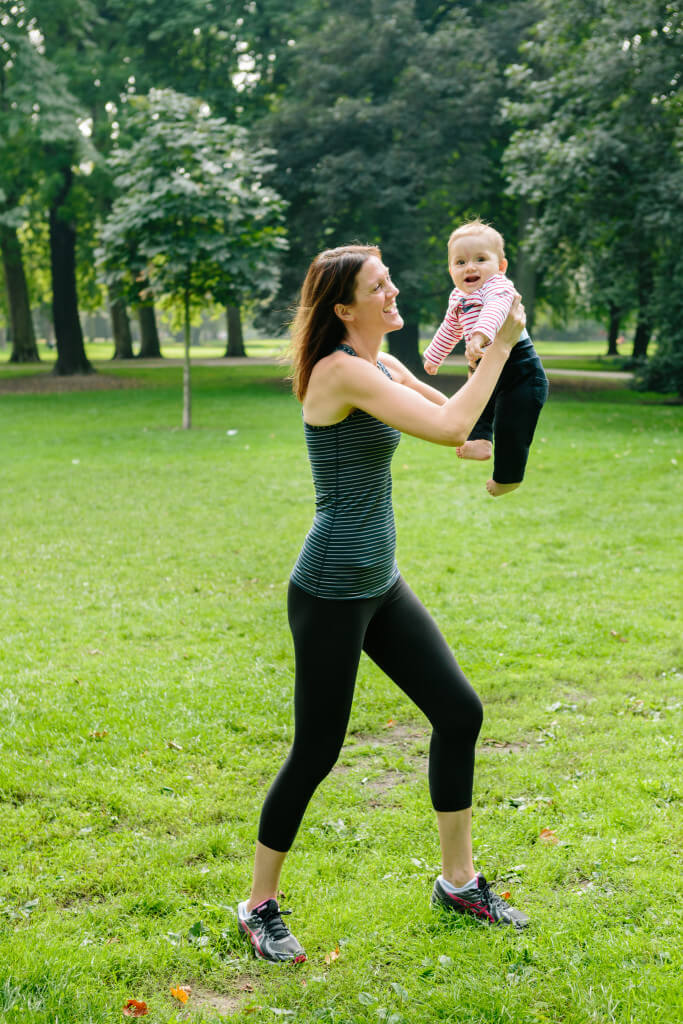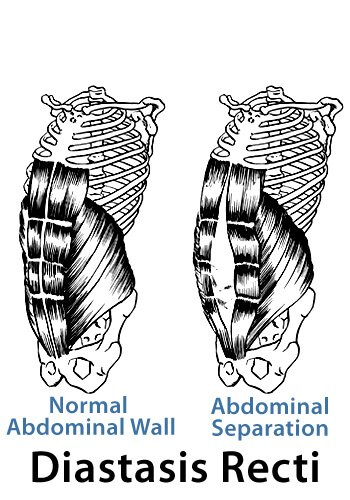How to Know if You Have Diastasis Recti…and What to Do About It
Diastasis Recti (Abdominal Separation) – PART ONE!
Diastasis Recti (DR), also known as abdominal separation, is one of those topics that you may have heard about or read about. But, in my experience, most moms are not quite sure what it is or whether they have it. How to know if you have diastasis recti is a common question asked by many women. There is surprisingly little included in pregnancy textbooks or online about this topic and I find many doctors and midwifes do not discuss it with moms-to-be in their check ups or new moms as part of their postpartum check up.
It is important to know about DR, both in pregnancy and post birth, because if you do have the condition (and you do not realize that you do) then you can unknowingly make the condition worse! This can lead to, amongst other things, back pain, postural issues, incontinence, that dreaded “mommy tummy” and, in the worse cases, a hernia that requires surgery!
In contrast, if you are aware that you have DR then during your pregnancy you can take steps to try to prevent it from getting worse (you cannot stop it completely). Additionally, post-birth you can do exercises to heal it naturally without the need for surgery. Knowledge is power!
What is Diastasis Recti?!?
Your core (or the central portion of your body excluding your arms, legs and head) is made up of a number of muscles that help you to maintain a correct posture. Having good posture is not just about whether you have rounded shoulders!! With a correct posture you keep your bones and joints properly aligned, which in turn limits abnormal wear and tear, decreases stress on ligaments, decreases the risk of strains and muscular pain, reduces the risk of back pain and injury.
Bonus? It’ll also make you look and feel better and slimmer!
The core muscles include your rectus abdominis (or “six pack”), your transversus abdominis (the deep core muscles often referred to as TVA), your obliques (at the sides of your core) and your erector spinae (that runs either side of your spine).
Your left and right rectus abdominis are separated by fiborous connective tissue known as your linea alba. If someone has a defined six pack then it is the linea alba you see as an indent running down the middle via the belly button.
During pregnancy, as your baby (and bump!) grow, your rectus abdominis and linea alba stretch to accommodate your growing baby. In the majority of pregnancies, the internal abdominal pressure of your uterus pressing against your rectus abdominis and the hormones in your system to loosen connective tissue leads to a gap forming between the right and left rectus abdominis and a stretching of the linea alba. Still wondering how to know if you have diastasis recti? You have DR if the gap between the left and right rectus abdominis is more than 2 – 2.5 finger widths apart. (“Diastasis” means separation and “recti” refers to your rectus abdominis.)
So now that you know what it is, when and how do you test to see if you have DR?

How to Know if You Have Diastasis Recti
DR most commonly develops during the latter part of the second trimester of your pregnancy or in your third trimester. (It can also exist in men and women that yo yo diet or do sit ups incorrectly or newborns!) The condition may develop sooner if you put on a lot of weight quickly at the start of your pregnancy, carry more than one baby, become pregnant again quickly after a first pregnancy, over 35 years of age or your have poor core strength pre-pregnancy.
After the birth of your baby in many cases, DR heals without medical intervention. I sometimes hear that women test 2-3 days after the birth. This is too soon. You need to give your body some time to heal and for your uterus to contract back again. Remember, you took 9 months to grow the baby so it’s a bit unfair to expect your body to recover in a matter of days!
How quickly you recover and heal will vary person to person. I recommend testing around 10 days to 2 weeks after the birth at the earliest and then again at regular intervals of every 2 weeks to check the gap and the strength of your linea alba below the gap. Don’t check every day! You will just get paranoid and it will be difficult to see the difference from day to day.
The DR Test
You can use the test set out below while pregnant or post birth. If you are unsure, speak to your doctor or midwife or a pre/post natal exercise specialist and ask them to check you. Always speak to your medical professional if you have pain or bulging from the belly button.
- Lay on your back with your knees bent and your feet flat on the floor.
- Exhale and lift your head and shoulders off the floor – put one hand behind your head to support your neck.
- Make sure you contract your rectus abdomens muscle – bring your rib cage closer to your hips, rather than just bringing up your head.
- Place your fingers in a horizontal position across your belly button and feel above, over and below the belly button. Assess the width and depth of the gap. It is also relevant if there is a gap how firm or loose the sheath under the belly button feels.
- If the width of the gap is more than 2 cm (about 2.5 fingers wide) you have DR.
If you do the test and find that you have DR – DO NOT PANIC!
I had a big first baby (4.3kg/9.5lb) and suffered with DR in my first pregnancy and postpartum. However, through precautions, I managed to ensure it was not too severe. Then, post-birth I closed the gap through exercise and avoiding exercises that caused it to worsen.
At 10 months postpartum, I became pregnant again! Whoops! At the time of writing I am 30 weeks pregnant with my second baby and my gap is about 2 finger widths apart – so on the edge of DR! My poor body had really not recovered from the first baby! But I am again taking precautions and am confident I can close it again post-baby. I know that having DR does not have to mean pain or surgery if you educate yourself with what you should and should not be doing.
What to Do About It?
Now that we’ve addressed how to know if you have diastasis recti, in Part 2 of this series we will discuss DR during pregnancy – what exercises to do, what exercises to avoid, the use of bands and taping and everyday tips to try to prevent the condition getting worse. And in Part 3 of this series we’ll discuss DR post-baby, so stay tuned!

Written by Claire Martin-Royle
Connect with Claire
If you would like to read more about Claire’s personal journey, or for more great tips on exercising in pregnancy and postpartum feel free to email Claire or follow her online.
Get your body back in just 12 weeks!
Need more help postpartum? If you’re ready to burn the baby fat and get your body back…check out the Beyond Baby Program and I’ll show you exactly how!
That’s right, if you’re a mom ready to GET YOUR BODY BACK (no matter how old your baby is), you’re in the right place. Click HERE and I’ll reveal how busy moms like YOU can burn fat and get your body back – in less than 3 hours per week.

